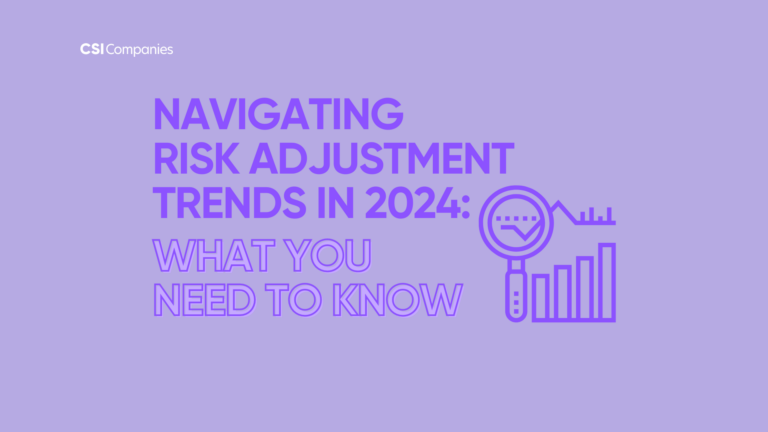Navigating Risk Adjustment Trends in 2024
What You Need to Know

Healthcare is in a constant state of flux. Often seen as a business “follower”, healthcare tends to wait for other industries to be disruptors and risk takers. The industry evolves in response to external influences, future estimations, inflation, and disease processes (cue COVID). The year 2023 brought a digital transformation, artificial intelligence (AI), and increased margin pressures. As we move into 2024, risk adjustment will be marked by the introduction of new payment methodologies, a thriving job market with a demand for skilled professionals, and further advancements in technology. Notably, navigating these changes and determining innovative business models will pose considerable challenges. As we look towards the horizon of risk adjustment in 2024, what lies ahead?
Telemedicine
The popularity of telemedicine is swiftly rising as an increasing number of patients are opting for this convenient method to stay healthy. The ease of a virtual visit, eliminating the need to travel to a physical location, and the added advantage of medication delivery to your doorstep have become the primary reasons behind its success. Moreover, it enables healthcare providers to expand their services and take proactive measures to help chronically ill patients. With the capacity to offer wearable device monitoring, telemedicine presents countless opportunities in healthcare. The extent of its future implementation is yet to be determined, but the significance it holds in managing heart disease and diabetes, among other chronic illnesses, is expected to bring vast improvements in 2024. As concierge medicine gains popularity, the telemedicine approach will likely experience a significant increase in patient visits.
Artificial Intelligence (AI)
Morgan Stanley estimates that a staggering 94% of healthcare companies have embraced the transformative power of AI. Looking ahead to 2024, an additional 11% investment in technology is expected, opening doors to a new era of healthcare innovation. Enhanced diagnostic tools and expanded remote monitoring capabilities will become the norm, revolutionizing the way risk adjustment coding is carried out. Traditional code capture methods, known for their time-consuming nature and proneness to errors, are being replaced by the efficiency of natural language processing (NLP), enabling the extraction of valuable data from clinical notes. Once extracted, AI steps in to analyze this data, uncovering patterns and trends that were previously hidden. As AI continues to evolve and elevate risk adjustment procedures, brace yourself for the benefits of increased automation and data mining.
Skilled Workforce
The scarcity of risk coding professionals is posing significant challenges for payers, who are grappling with numerous reporting deadlines, the need to maintain existing accounts, and ensuring accurate claims submission. Health system executives are bracing themselves for talent shortages and workforce issues to impact their financial performance in 2024. Recruiting, retaining, and nurturing new talent will be an uphill battle for healthcare leaders in the coming year. As the assignment of HCC codes becomes increasingly intricate and the demands of value-based care continue to escalate, the risk adjustment coder talent pool will likely experience further depletion.
Version 28 CMS HCC Model
In the upcoming payment year of 2024, the Centers for Medicare and Medicaid Services (CMS) will introduce a new Hierarchical Condition Category (HCC) model, bringing significant changes to the capitation rate, number of HCCs, and methodologies involved. However, many organizations may find themselves unprepared for the financial implications of this new version and the long-term challenges of effectively managing patients’ chronic conditions. To mitigate the financial impact health plans must ensure their code capture functions are at the top of their game. AAPC estimates a 14% error rate in risk code assignment, translating into large financial losses. As we enter 2024, expect to see Phase 1 of the new payment methodology being implemented, accompanied by changes in the diagnoses eligible for risk adjustment. This will undoubtedly increase the pressure on healthcare providers to ensure accurate and precise code assignments.
RADV Audits
The Risk Adjustment Data Validation (RADV) program will be used to identify improper payments to Medicare Advantage payers. This new audit program is expected to return $4.7 billion over the next 10 years to the Medicare program. The program excludes the fee-for-service (FFS) adjuster and adds an extrapolation methodology. This new methodology can result in large penalties that health plans are not prepared for. Coupled with the existing challenges of a shortage in a skilled workforce and staffing, health plans find themselves at considerable risk. Therefore, in the year 2024, it is imperative for payers to proactively prepare for the possibility of a RADV audit and implement an internal auditing process to ensure accurate and precise capture of risk adjustment codes. Be on the lookout for penalties related to inappropriate coding and heightened scrutiny of code capture practices in the coming year.
Outsourcing
The year 2024 will witness an ongoing surge of financial pressures for healthcare services. Challenging margins, lack of a skilled workforce, and increased audit scrutiny will continue to place pressure on health plans and providers. To compensate for these stressors, many organizations are choosing to outsource functions such as coding. Revenue cycle, billing, and claims management are frequently outsourced to streamline operations and reduce overhead costs. According to Forbes the growing demands for cost-effective services, increase in technology adoption, and the need for customized solutions are driving outsourcing to a $450 billion worldwide project. Expect to witness the continuation of financial pressures on the industry, with outsourcing increasingly becoming a strategic initiative for many healthcare organizations.
In conclusion, the year 2024 will shed light on longstanding issues while presenting novel challenges in the healthcare industry. At CSI Companies, we specialize in customizable solutions for our clients that set them up for success. Whether your needs are small or large, CSI can scale to size for any project or managed service opportunity. Reach out today at ccisolutions@csicompanies.com and let’s work together in 2024.